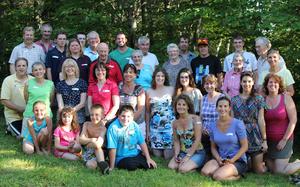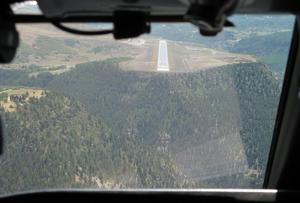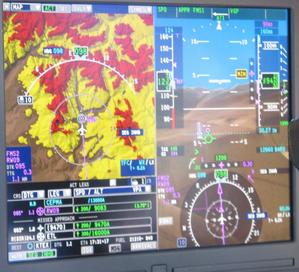Engine Issues
- Details
- Written by Kevin Horton
- Hits: 4360
There were a couple of things about the engine that troubled me on the way back from Yarmouth on Tuesday. The rate of climb was noticeably lower than expected above 6,000 ft. And the #2 cylinder Exhaust Gas Temperature (EGT) didn’t vary quite the same as normal when I leaned the mixture in cruise. I hoped that I simply had a partially plugged fuel injection nozzle, which would cause the #2 cylinder to be running too lean, and the others to be too rich during the climb (I lean during climb to keep the highest EGT at the value seen during take-off, as recommended by Advanced Pilot Seminars and John Deakin).
This morning I pulled the cowling and inspected the fuel injection nozzles. I couldn’t see any evidence of a partially plugged nozzle, but I cleaned them with an ultrasonic cleaner, and reinstalled them in the same cylinders they came from. I checked the air filter - it was in good shape, but I cleaned and reoiled it. Still looking for the smoking gun, I did a differential compression check. Three cylinders were good, but #3 was worryingly low at 63/80 (normal is in the 70s). Air was felt to be coming out the exhaust pipe, which means the exhaust valve was leaking. This cylinder was 74/80 on the previous compression check, but it was the only cylinder where the escaping air was coming from the exhaust on that check.
I removed the rocker cover and “staked” the exhaust valve with a dowel and a hammer to open it and possibly dislodge any foreign material between the valve and valve seat. I checked the compression again, and this time it was 60/80. The compression check was done cold, so I would need to redo it after flying the aircraft to warm up the cylinders to confirm the result. But, I had found a broken flange on a heat muff inlet SCAT hose, which I would need to fix before flying.
I still hadn’t found the cause of the too low climb rate, as a leaking exhaust valve wouldn’t have much effect on power, so I decided to cut open the oil filter from my last oil change. I had meant to inspect the filter a few days after the oil change, after it had drained, but that slipped through the cracks. After cutting the filter open, I was very dismayed to see quite a bit of ferrous metal in the oil filter. Every pleat in the filter had several dozen very small pieces of metal. The filter from the previous change had been almost completely clean, so something had happened in the 50 hours between oil changes.
Lycoming has published a long list of inspection criteria, based on the quantity, size and type of metal. I’ll acquire some solvent tomorrow to rinse the filter media so I can quantify the amount of metal. I’ll also take a look in the filter that has been on the aircraft for the 20 hours since the last oil change before calling Aero Sport Power to get their advice. I think the next step is to pull a cylinder or two so I can inspect the camshaft lobes. Given the amount of metal in the filter, I fear the engine should be disassembled for an inspection to find the cause. I would also need to flush the oil cooler and lines, and possibly have the prop governor overhauled. The prop would also need to at least be flushed - I’ll need to talk to an MT prop shop to get advice.
I’ve decided not to fly the aircraft to Oshkosh this year for the big fly-in at the end of July. I’m going to be on the road for a week between now and Oshkosh, and that doesn’t leave enough time to get things sorted out. There are too many long stretches with nothing but trees between here and Oshkosh to risk flying there before I get to the bottom of things. It’s going to be painful doing that drive.
Family Reunion
- Details
- Written by Kevin Horton
- Hits: 3417
 It’s been a crazy two weeks. We had two of Terry’s sisters in town for a week, then we flew to Yarmouth, Nova Scotia for a Horton family reunion over the last weekend. The reunion was great - I talked to cousins I hadn’t seen in over 30 years - I left home to join the military the day after my high school graduation in 1978, and have only been home for a few day a year since. My brother also left home shortly after high school, so this was the first time since 1985 that my brother, sister and I have been all at home at the same time. It was a great weekend.
It’s been a crazy two weeks. We had two of Terry’s sisters in town for a week, then we flew to Yarmouth, Nova Scotia for a Horton family reunion over the last weekend. The reunion was great - I talked to cousins I hadn’t seen in over 30 years - I left home to join the military the day after my high school graduation in 1978, and have only been home for a few day a year since. My brother also left home shortly after high school, so this was the first time since 1985 that my brother, sister and I have been all at home at the same time. It was a great weekend.
We flew down on Friday afternoon, and flew back home today. Both flights went very smoothly - 2:42 to fly down, and 3:11 to fly home (roughly 7 hours, door to door, including driving to and from airports). This sure beats driving (about 18 hours, including a ferry ride), train + rental car (almost 48 hours) or airlines + rental car (about 7 hours door to door).
I did manage to do the recent Trio autopilot servo “Mandatory Field Change” before Terry’s sisters arrived.
The one big downer is that this weekend I somehow managed to crunch the lens of my new Canon SX 230HS digital camera. Now the sliding door that covers the lens is bent, and the cover no longer closes. Drat!
Breakfast in Cornwall
- Details
- Written by Kevin Horton
- Hits: 2933
This morning I flew down to the Father’s Day Fly-In Breakfast at Cornwall. It was a beautiful day, perfect for flying, and they had a very good turnout of aircraft and drive-in visitors. My landing wasn’t the best, with a bit of a bounce. But I still made the turn-off at taxiway A, about 900 ft from the threshold of the runway.
Several attendees came over to the aircraft immediately after I shutdown to take a closer look. Two of them mentioned seeing the Golden Hawks perform when they were much younger.
Two Weeks in Wichita
- Details
- Written by Kevin Horton
- Hits: 2964
 I spent the last two weeks in Wichita, KS, getting back home on Friday. It was a busy trip, with a bunch of ground and flight testing on two Global Express avionics updates. One of the flights went to the airport at Telluride, CO, to assess SVS performance. We hit a fairly significant windshear on short final to runway 9, so we did a go-around and I tried runway 27, which worked much better.
I spent the last two weeks in Wichita, KS, getting back home on Friday. It was a busy trip, with a bunch of ground and flight testing on two Global Express avionics updates. One of the flights went to the airport at Telluride, CO, to assess SVS performance. We hit a fairly significant windshear on short final to runway 9, so we did a go-around and I tried runway 27, which worked much better.
Final for runway 9 in Telluride.
 The SVS image on final for runway 9. The SVS was well behaved, and it gives a very good depiction of the terrain ahead of the aircraft. This would provide a very aid to situational awareness at night, or when flying an instrument approach.
The SVS image on final for runway 9. The SVS was well behaved, and it gives a very good depiction of the terrain ahead of the aircraft. This would provide a very aid to situational awareness at night, or when flying an instrument approach.
 Final turn for runway 27. They’ve done a lot of work to partially fill in the bowl that the runway is in since I was first there in 2008.
Final turn for runway 27. They’ve done a lot of work to partially fill in the bowl that the runway is in since I was first there in 2008.
Wax Job - Fuselage Bottom
- Details
- Written by Kevin Horton
- Hits: 2290
There was no flying this weekend. Too many things to do on Saturday, and Sunday was the annual Smiths Falls Flying Club Fly-In Breakfast. It is a very important fund-raiser for the club, and the club operates the airfield where our RV–8 is based, so I help out at this event every year.
Rain showers had moved in by the time the Fly-In Breakfast had finished, so I gave up on any thoughts of flying. Instead, I washed and waxed the bottom of the fuselage. We did the upper surfaces and fuselage sides two weeks ago, but the lower surfaces still need attention. I’ll attack the bottom of one of the wings next time.
I put the tail wheel up on a stand while doing the wash and wax, to make it easier to get under the rear fuselage. This lowered the forward part of the aircraft closer to the floor than usual, and I managed to bash my head against the end of one of the exhaust pipes as I sat up, drawing blood. Ouch! At least I didn’t bend the exhaust pipe. Then I did it a second time a few minutes later! Slow learner, I guess
IFR Fuel Capacity
- Details
- Written by Kevin Horton
- Hits: 2442
When I was building the aircraft I agonized over whether to add extended range fuel tanks. I was afraid that the standard 42 USG may not be enough for IFR flights with the need to have sufficient fuel to fly to the destination, shoot an instrument approach, then fly to an alternate airport and arrive there with 45 minutes of fuel. It would be quite a bit of extra work to add extended range tanks, and the added weight and complication would be there on every flight, whether the fuel was needed or not. So, I decided to get the aircraft flying with the standard fuel quantity, and add extra fuel later if it proved to be needed.
The long trip this weekend was the first IFR trip where I had to start paying very close attention to the amount of fuel remaining. We flew 467 nm to Yarmouth, and did two ILS approaches with a missed approach on each one. The filed IFR alternate was Fredericton, NB, 120 nm away. But, the weather in Halifax had improved to 500 ft overcast with 12 mile visibility, which would be more than adequate if it held. I determined that if I slowed to economy cruise of 140 kt at 6 USG/h fuel flow I had lots of fuel to fly 128 nm to Halifax, shoot an approach and then make it to Fredericton if needed. In the end the weather at Halifax continued to improve, and we easily got in, landing with almost 12 USG of fuel on board, after 3:39 of flying (600 nm), three instrument approaches and two climbs to 9000 ft altitude. This was about two hours of fuel remaining at economy cruise of 140 kt at 6 USG/h.
Conclusion - 42 USG fuel is completely adequate for foreseeable IFR ops on this aircraft.
